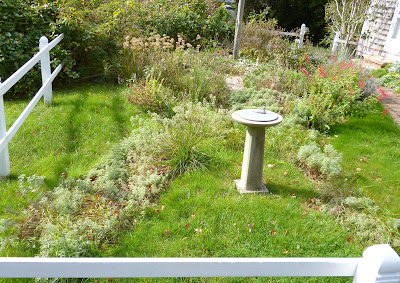The front cover of this booklet, published by Powwow River Books of Amesbury for the Whittier Home Association, shows a pen drawing of Elizabeth Hussey Whittier by Catherine Wingate Cameron, with an example of her handwriting as the background. The Introduction is by Frances C. Dowd, a former President of the Whittier Home Association who also transcribed the diary with no silent corrections.
The Introduction tells me several things of which I wasn't aware, such as Elizabeth publishing a small volume of poetry, and having several poems published in different magazines; her spending a few months in Pennsylvania with brother 'Greenleaf' (who was working for the Pennsylvania Freeman), which was the only time that she spent away from Amesbury; and that Elizabeth and Whittier returned to Amesbury after his office was burned in an apparent reaction against the anti-slavery movement.
The diary gives very interesting insight into the thoughts of Whittier's sister, into the mind of the Quaker, and to some extent into Whittier's own world, although far too much here is unexplained, and the reader must guess certain things or (far more often) remain ignorant. Footnotes would have been very helpful, as there are many references to abbreviated names, so who are these people? Even if they're not known by the editor, or if their identity is uncertain, then a note to that effect, perhaps with a suggestion, would have helped. For instance, maybe not many readers would know today that Elizabeth's reference to 'Mrs. Hemans' on page 4 is to the popular poet Felicia Hemans, although most people would probably have heard of a boy standing on a burning deck, so a footnote would have been informative. As it is, Hemans is not even mentioned in the Index.
Oh yes, the Index. Strings of words have been keyed in, run through an alphabetical program, and the poem names (in quotes) have floated to the top of the list like cream, leaving a list in perfect alphabetical order. Only, the purpose of an Index is to find the page(s) a reference refers to, but this Index refuses to work that way, unless by sheer coincidence.
Let's take at random, for example, the single Index entries 'Amkanoonaks', 'Mirick, B. L., Mrs.', 'Racoon Mountain', and finally 'Sophronia M' or ''M., Sophronia' if we want to be pedantic and doublecheck. The page numbers given for these entries, respectively, are 16, 26, 16, and 8 (that last number referring to both Sophronia entries). But if we look up these numbers, no such reference is on any of those pages. But like magic, if we add six pages to each of these numbers, they appear on pages 22, 32, 22, and 14 repectively. The numbered pages in the book begin at the page marked '1' (the beginning of Elizabeth's diary, which ends at the page marked '34') and end at the page marked '40', which is the final page of the Index. Logically, there should, in an Index that subtracts six pages, be no number above 28. But to take one example, there are four references to 'Amesbury', one of which is to page 29, which is a self-reference to the appearance of the town in the Index itself. So you just add six? Well, not quite: 'Campbell' should be on page 36, in other words page 40, but it's not there: we don't live in a perfect world, but this error could have been easily checked before publication.
I don't intend my comments to be taken very seriously, and I realize that the wonderful work for the Whittier Home Association is voluntary and an excellent job has been done transcribing what doesn't look very easy-to-read handwriting, but all the same an editor normally says a few words about the actual editing of a work, although there's nothing here. I have a large number of questions about the people alluded to in Elizabeth's diary, but unfortunately I don't have any answers.






















































